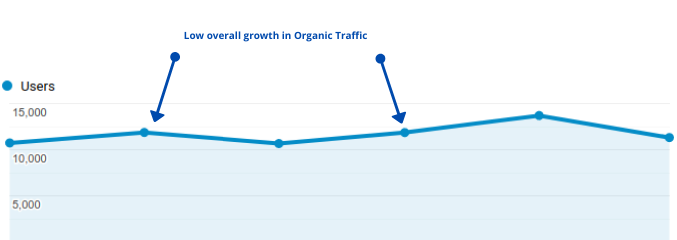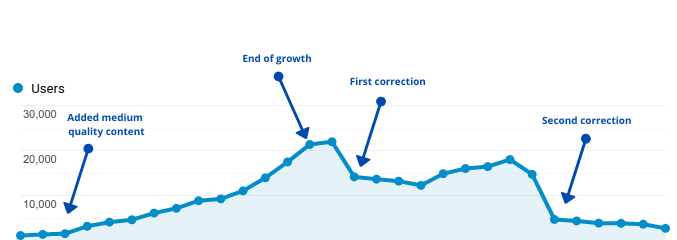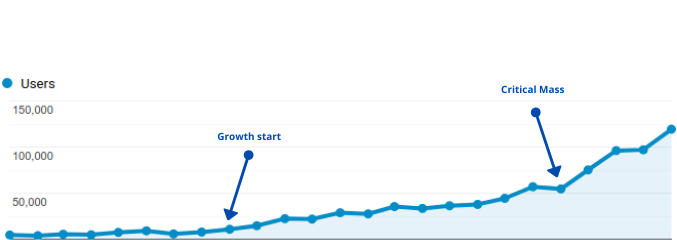3 scenarios for organic growth in google
Do you know that feeling that your website is just standing still and whatever you try it just doesn't work. somehow how you are unable to attract more traffic from Google. you might wonder how other websites do this. And why doesn't this work for me?We compared to 3 most common scenarios for you.
The 'stop and focus on quality' scenario
This scenario is actually the most common scenario. Your website is more or less done and the focus has shifted from adding new content to improving the quality of the website.
Improving low quality content can sometimes be a good idea if the quality of a number of pages is really below par, but that is not always the case. Most serious businesses have their content well in order. In this scenario, there is usually not so much more to gain by tinkering with a website that actually already performs quite well
.

Let's take a closer look at this. This often happens with high(ish) quality / low quantity websites that have maybe 10-50 high-quality articles. Your site performs well on some keywords but you are never quite able to rank on those high volume keywords in Google. You miss the reputation, trust and the associated natural organic backlinks that come with that trust and reputation.
The 'expand too quickly' scenario
The following scenario occurs when you take shortcuts to grow faster. You add a high number of mediocre-quality articles within a short time. This is a major pitfall that many website owners fall for, whether or not due to bad advice from a 'no-cure-no-pay seo expert'. In the beginning this tactic might seem to pay off. After a short period of strong growth a correction occurs. Often a short period of moderate growth is followed. Only to be followed by the second major correction, after which , you are often even worse than in the initial situation.

This usually happens so you have quantity but not quality, if you add a large number of poor quality articles to your site in a short time. You might initially get a lot of traffic from Google in a short time. But Google is not stupid. Google so found out that this is not the type of content visitors are looking for and you'll see your traffic gains melting away like ice.
In this scenario visitors and search engines will quickly lose confidence in your site. There is a good chance that, at some point, visitors will click on a link and navigate to a low content page that they do not like. Those visitors will then leave your web page and are will probably not return any time soon.
The 'critical mass' scenario
The Final scenario is the critical mass scenario. It assumes that the traffic on your page stays behind expectations because the critical mass has not yet reached. Critical mass is the point at which the site finally has enough qualitative content to increases the traffic to the website exponentially. 
Critical mass is achieved by combining quality and quantity. Unfortunately, quality alone is not enough to rank in the search results. You cannot just start a site with a single high quality article and expect to to end up on the first page of the search engine results. If so, the SERP would change drastically every day. No, you also need quantity and lost of it.
As described, quantity alone is also not enough. Many low-quality pages do not ensure that your visitor numbers will continue to rise in the long term.
When there is enough high-quality content on your site, then something magical will happen at this point. The site will rise above itself, as it were. We call this the Reaching critical mass .
Critical mass means there is so much great content on the site that visitors and search engines will pick this up. Your site is now seen as a source of expertise within your area, not only by visitors but also by Google. other sites will link to your content without any hesitation, Resulting in those hard to get natural organic backlinks. Google will trust the content that you post online much faster and with much less hesitation.
What exactly is High quality content?
We are talking a lot about high quality content in this article without really explaining it. What high quality content is exactly that differs per industry. In highly competitive industries, we're a lot of money, time and effort is being spent in writing articles, the bar is much higher than in other industries. But no matter how good or bad the competition, the principle remains the same. The content that you create should be better than the content of your competitor.
When writing an article, try to follow the following guidelines. Write clear, easy to read articles with sufficient content, at least 600 words. Before and during writing, keep Bird's-eye view and look at all parts of a subject. Discuss the advantages, the disadvantages, the technical specifications, but above all, be helpful and informative. Especially the soft, informative and helpful part, Separates the high ranking articles from the less world ranking articles. Always answer search intention and any questions a visitor may have.
A great example that I often quote is the taxi world. Taxi sites that outperform other taxi sites pay a lot more attention to customer-friendly information. They do not emphasize what a taxi company is and what it does, but rather take away as much uncertainty as possible. For example from what you might expect when call a cab: how they will help you with your suitcases, how to book a ride, what 2 expect from the taxi driver etc. Any information that a customer would appreciate.
.
Technical seo
a/b testing
Above the fold
Alt-tag
Anchor text
Black hat seo
Bounce rate
Broken links
Canonical tag
Cloaking
Content farm
Crawler
Duplicate content
Structured data
Google algorithm
Google Panda
Google penalty
Google penguin
Googlebot
Crawler Traps
Advanced Search operators
Inernal nofollow
Ranking Signal correlation
Google BERT
Linkuilding
Social Media
Website speed
Time to first byte
First Contentful Paint
Inline CSS
Defer JavaScript
Largest Contentful Paint
Resources
Smart WebFont loading for better performance
Icon fonts lazy loading
Improve page rendering with content-visibility
Analytics without Core Web Vitals delay
Self host Google fonts tutorial